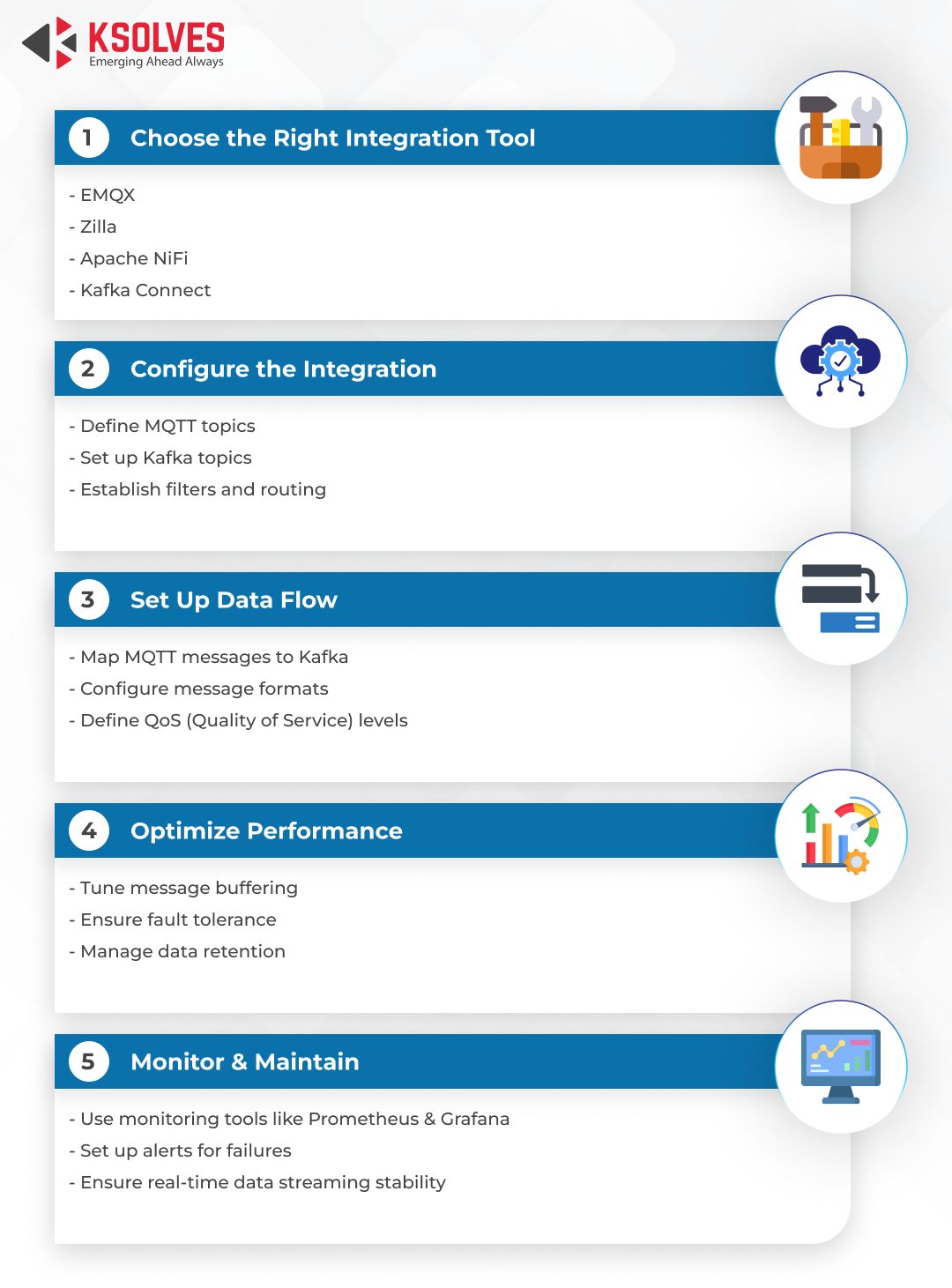MQTT to Kafka: Seamless Integration For Real-Time Data Processing in IoT
Apache Kafka
5 MIN READ
February 27, 2025
![]()

With the rise of the Internet of Things (IoT), businesses now have access to real-time data processing, which empowers smarter and faster decision-making. However, as systems grow and data expands, managing and analyzing it can feel overwhelming. That’s where a reliable, cost-effective, and scalable solution becomes essential. A promising solution is to blend MQTT with Kafka, creating a streamlined pipeline for real-time data processing. In this blog, we’ll uncover how MQTT to Kafka integration can bring value to your business.
Introduction: MQTT & Kafka
As we delve deeper, let us pause and understand these platforms first.
MQTT (Message Queuing Telemetry Transport)
MQTT is a standard messaging protocol that was formerly used for machine-to-machine communication. But today, MQTT has become a prominent choice for IoT data transmission. This protocol requires minimum resources and consumes little power. It also comes with an in-built communication feature that allows you to connect with multiple IoT devices.
Kafka
Apache Kafka is a distributed event streaming platform designed for high-throughput data pipelines, real-time analytics, and pub/sub messaging.” Kafka is a messaging platform that aims to achieve the purpose of the constant flow of data. In this way, it eliminates the need for messages to be held until they are required to be examined, enabling businesses to use Kafka to better manipulate large amounts of data seamlessly in real time.
Kafka vs MQTT | What Are The Key Differences?
| Factors | MQTT | Kafka |
| Messaging Model | In the MQTT protocol, publishing messages means that every subscriber to a topic will receive all the messages. It also includes a shared subscription option, which helps balance the load across multiple subscribers. | In Kafka, the publish-subscribe model is enhanced with a queue-like structure, which uses partitions within topics. This structure facilitates distributed consumption and helps maintain load balance. |
| Message Delivery | MQTT has three layers of message delivery.
1. QoS 0 (At most once): No guarantee of delivery. |
Messages are usually delivered at least once, while other options require unique settings. |
| Saving Messages | Only the latest message on the topic can be saved. | All messages can be either for some time or forever. |
| Handling Failures | MQTT does not handle the system failure by itself. | Kafka ensures fault tolerance by replicating partitions across multiple brokers. |
| Ease of Use | Easy to set up and use, especially for small projects. | More complex to set up and manage when working on big projects. |
| Integration | Best integrated with IoT platforms and edge devices. | Integrates with big data tools like Spark, Flink, and Hadoop. |
| Security | You can use a secure connection depending upon the broker. | It offers multiple security features but needs careful setups. |
| Device Requirements | It works well with small, low-power devices. | It needs strong computers and plenty of memory to work |
| Network | Designed for low-bandwidth, high-latency environments, such as satellite or mobile networks. | It requires a robust network as it operates with a higher payload and throughput. It is best suited for data centers or reliable networks. |
Benefits Of MQTT and Kafka
MQTT or Kafka has advantages when used individually. Now let’s explore how integrating these two technologies can increase the efficiency of your business.
Scalability
When Kafka is combined with MQTT, the system’s overall strength is improved. It lets you manage multiple devices in parallel without worrying about slowing down the system. Hence, the combination of these two technologies opens the door to new opportunities for the business.
Reliability
MQTT and Kafka interconnection improves data transmission, making the system more reliable. MQTT on the one hand ensures that data delivery becomes more reliable. On the other hand, Kafka reduces the chance of data loss during transmission.
Stream Processing
Kafka remains the go-to streaming tool for stream processing. It is crucial for extracting insights from massive datasets that need to be processed in real-time. Such rapid processing of vast data becomes foundational for quicker decision-making in the business domain.
Decoupling
The increasing interest in Internet of Things (IoT) devices has popularized the MQTT standard. It enhances remote data acquisition capabilities and influences resource distribution. Kafka takes abstraction a step further and adds a messaging queueing system, which allows it to meet the users’ needs.
Use Cases of MQTT to Kafka
Here are a few practical scenarios where this combination can be beneficial.
Connected Cars and IoV (Internet of Vehicles)
In the smart world, our vehicles are getting smart with the help of a connected car ecosystem. The sensors installed in the vehicles generate real-time data about their performance. This data can convey critical information about engine health, tire pressure, and fuel levels. Further, MQTT can transmit this data because it works perfectly in an environment with low bandwidth. Once the data reaches the central system, Kafka processes and organizes it. It also ensures that the data is available in real-time for analysis purposes.
Smart Cities
Smart cities use an array of connected sensors and devices to improve residents’ quality of life. These cities collect and analyze real-time data, which requires reliable communication to manage and analyze. That’s where MQTT to Kafka comes into the picture. Kafka ensures real-time data processing while MQTT offers a scalable solution. Thus the combination of both satisfies the city’s growing real-time analysis needs.
Healthcare
Doctors can monitor patients’ conditions using wearable devices to respond quickly during emergencies. Now, integrating Kafka and MQTT can significantly enhance real-time monitoring. Kafka can handle massive data from wearable devices and facilitate real-time processing. Meanwhile, MQTT fosters seamless communication between devices and central systems.
Industrial IoT
IoT enhances the efficiency and productivity of the industries by minimizing downtime. It uses various sensors to monitor the machines’ temperature, pressure, and vibration. So, in case of abnormalities, it can send alerts to your team for preventive action. The publish-subscribe model of MQTT allows easy communication with each other and the central system, whereas Kafka’s flexible architecture supports a wide range of use cases.
Methods For Connecting MQTT To Kafka
Direct Integration via MQTT-Kafka Bridge
The MQTT-Kafka bridge acts as a connector which offers a seamless data transfer. It helps organizations achieve efficient and reliable data streaming solutions without any massive changes in their infrastructure. Organizations can even create custom bridges using an open-source MQTT broker.
Application Of Schema Management
Schema management ensures data consistency and compatibility across the system. Additionally, this helps reduce any operational risks associated with changes needed for field data collection, as the customers do not have to set definitions and do the tasks listed in the fillable segment.
External Systems Using Kafka Connect
When MQTT Connect is employed, additional integration costs are minimized as it requires less effort to set up the basic connectors. Moreover, it provides a pre-built connector for standard integration. It also ensures that the data is ingested efficiently and processed with minimal setting.
Step-by-Step Guide: MQTT to Kafka
Method 1: Using an Integration Tool
Using the integration tool is one of the simplest techniques for connecting Kafka with MQTT. Start by picking the best integration tool such as EMQX, Zilla, Apache NiFi, or Kafka Connect. Then, set up the topics, filters, or other parameters related to your project requirements.
- Choose the Right Integration Tool
– EMQX
– Zilla
– Apache NiFi
– Kafka Connect
- Configure the Integration
– Define MQTT topics
– Set up Kafka topics
– Establish filters and routing
- Set Up Data Flow
– Map MQTT messages to Kafka
– Configure message formats
– Define QoS (Quality of Service) levels
- Optimize Performance
– Tune message buffering
– Ensure fault tolerance
– Manage data retention
- Monitor & Maintain
– Use monitoring tools like Prometheus & Grafana
– Set up alerts for failures
– Ensure real-time data streaming stability
Method 2: Building a Custom Integration
Using MQTT broker
- Import the Mosquitto or EMQX MQTT brokers to be able to set up a start-up process.
- After this, you must define topics for receiving the MQTT messages.
- Next, import the Kafka Cluster.
- Finally, write a Kafka producer application in your preferred language. This application will help you connect to the MQTT broker and convert them into Kafka messages.
MQTT to Kafka Bridge Guide
- To link both systems, use an MQTT-Kafka bridge or Kafka Connect.
- You will first need to link the bridge or plugins Kafka Connect.
- Then, configure the integration parameters, defining the linkage between the topics imported in Kafka and the messages imported in MQ.
- Finally, test the data flow to confirm that messages are sent properly.
When to use MQTT, Kafka, or Both?
MQTT and Kafka are both employed for data exchange and data processing. However, they are designed for different tasks and appropriately used for various situations:
MQTT
Use MQTT when you need to:
- Connect a large number of devices
- Use a lightweight push-based messaging solution
- Communicate reliably over low-bandwidth networks
- Deliver messages quickly
Kafka
Use Kafka when you need to:
- Store and process large amounts of data in real-time
- Integrate data
- Handle high throughputs of messages
- Exchange data between applications
In most IoT application scenarios, it is helpful to integrate both MQTT and Kafka:
- MQTT: Transmits data from IoT devices
- Kafka: Stores and processes data, such as analyzing and saving it for later use.
For Example:
Connected car infrastructure, Smart cities and homes, Smart retail and customer 360, and Intelligent manufacturing.
Final Thoughts
Connecting MQTT to Kafka can be an excellent IoT solution for businesses in almost every aspect. One of the advantages of MQTT is the guaranteed delivery of messages from IoT devices. The other advantage is that Kafka serves to ensure data availability and reliability. Contact Ksolves to tap into the benefits of real-time data analytics for your enterprise. We have the experience and knowledge necessary to break new ground in your Industry with our powerful real-time data streaming capabilities. Our professional team comprises certified experts who can provide out-of-the-box Apache Kafka development services for your company. Moreover, our team simplifies the process of data collection from different sources to help you capture valuable insight about your business.
![]()





AUTHOR
Apache Kafka
Atul Khanduri, a seasoned Associate Technical Head at Ksolves India Ltd., has 12+ years of expertise in Big Data, Data Engineering, and DevOps. Skilled in Java, Python, Kubernetes, and cloud platforms (AWS, Azure, GCP), he specializes in scalable data solutions and enterprise architectures.
Share with